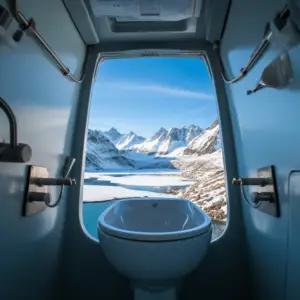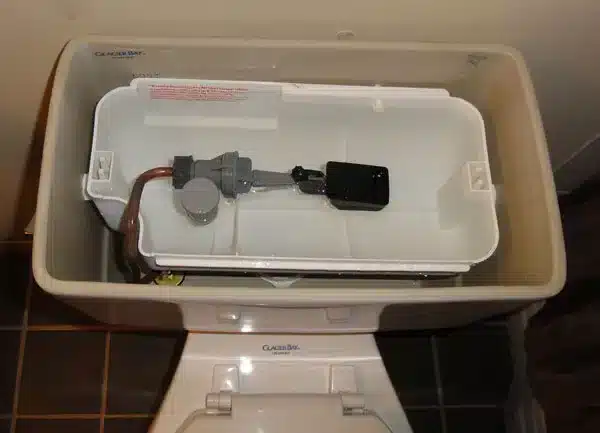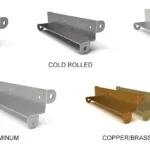Table of Contents
Glacier Bay Flapperless Toilet Keeps Running

Flapperless Toilets, A toilet isn’t supposed to keep flushing. If your toilet keeps running, the issue may lie with a faulty mechanism or simply a buildup of debris. Either way, you can learn how to fix it before you call a plumber.
Flapperless toilets are a growing trend in the U.S., but they are not without their drawbacks. These toilets use gravity and the pressure of water in their tank to push waste down through the trapway and into your home’s sewer system. In some cases, it can be frustrating to deal with a flapperless toilet that keeps running.
If your Glacier Bay flapperless toilet keeps running, there are a few things you can try to fix the problem.
what to Do if Glacier Bay Flapperless Toilet Keeps Running
Replace or Clean the Old Fill Valve
Sometimes the fill valve will get clogged with mineral deposits and need replacement or cleaning.
The fill valve is what sends water into your toilet tank. If it’s not working properly, then your toilet will continue to run even after you flush it.
The best way to repair this problem is to replace the fill valve. You can do this yourself because it’s not difficult, and it will save you money on plumbing bills.
Flush the tank until its water is clear, and then check inside to make sure no debris remains in the valve. Reattach it, and turn on your water again—flush if necessary—to make sure that everything works properly.
If flushing doesn’t solve your problem, it is likely that you need to replace the fill valve. The model number of a fill valve varies by toilet; check your toilet’s model number and get one from a store of that size or larger.
If your toilet is six years old or older, it might be time to replace the flushing mechanism. Flush valves tend to wear out after too many harmful cleaning agents have been used on them.
Adjust the Lever Chain
The Glacier Bay flapperless toilet lever chain controls bowl water flow. Lever chain regulation may keep your toilet running. The chain must be loose enough for the lever to move. Long chains might get snagged and jam, so trim them if needed. To solve this, remove your toilet tank lid and check for damage. If functioning, lengthen it as needed. If it’s too short to adjust, replace it.
Before replacing the lever chain, make sure that there is enough slack in the chain so that it doesn’t make contact with any other part of your toilet tank. Also, make sure that there are no kinks in the chain that can cause friction when opening or closing the flapperless valve.
Regulate the Toilet Water Level
You’ll want to adjust the water level in your toilet tank so that it’s about 1″ below where it needs to be for proper drainage purposes. If there’s too much water in your tank, then this can cause problems with your flapperless toilet keeping running due to excess water being present when it tries to drain itself out of its pipes (which can clog up if there’s too much water present).
If the water level is not maintained at a constant height, it can cause other parts to break before they should.
Leakage
The most common leakage points are the tank and fill valves. When the tank fills, water is pushed through the fill valve into the bowl of the toilet. If the water pressure is strong enough, or if there’s some kind of blockage in the line, it can cause the toilet to run continuously until someone notices or until it overflows.
To fix this, you’ll need to adjust the water pressure, clean out any debris that may be blocking the line or the flush valve, and check for leaks at all connection points.
How Much Water Is Wasted?

Flapperless toilets are a great alternative to traditional flush toilet systems. They save water and money and can also be much more efficient than other toilets. Still, you can waste a lot of water if your toilet keeps running.
A running toilet can waste more than a gallon of water each hour. That’s about one unit of water every month!
If you have an older toilet, one that uses 3.5 gallons per flush (GPF) or 1.6 gpf, then you’ll be wasting a lot more than someone with a newer model that uses 1.6 GPF or less. However, if you’re running your toilet all day long because it’s leaking, then it doesn’t matter how efficient your toilet is — you’re still wasting water!
If your toilet keeps running after you’ve flushed it, then there’s probably something wrong with either the flapper or with how well it seals against the rubber stopper at the bottom of your tank. Either that or the chain lever and water level need adjusting.
Conclusion
Glacier Bay flapperless toilets have been around for nearly a decade. They are a great alternative to traditional flushing toilets, but they also have their own set of problems that can make them unreliable. If your Glacier Bay toilet keeps running, there are several possible causes for this problem.
Remove the tank lid and remove any debris from inside. Clean the fill valve to make sure it is clear of debris and mineral deposits. Reattach the fill valve and turn on your water supply. Turn the water level and lever chain adjustments to appropriate positions. Flush the toilet and check for leaks. If there are no leaks, turn on your water supply again and flush your toilet to make sure all is working properly.
If none of these solutions work, then there may be a problem with your flapperless toilet itself or its water supply system. It’s best if you call a professional plumber to fix your problem before it gets worse.


